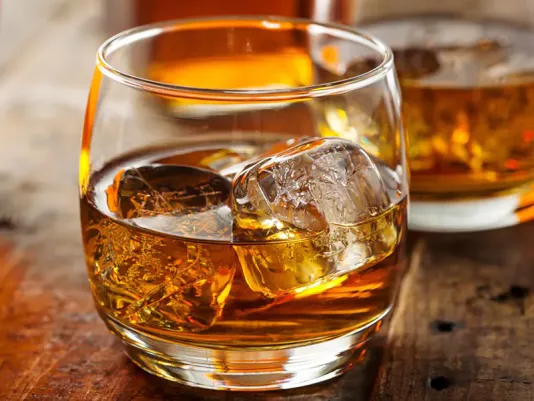Pumpkin Cocktail
Pumpkin Cocktail is a simple American cocktail recipe for the fall season.

Bourbon is an ingredient I learned to appreciate many years ago when I began discovering the culinary secrets of different world cuisines. In my practice, it proved to be a versatile ally – with its help, I managed to give dishes a special charm. Over many years of cooking, I realized that bourbon is not just a drink but a true spice in liquid form. Its sweet, woody aroma highlights meat dishes beautifully, while its warm caramel notes I especially value in desserts and baking. In my family, we always loved sauces where I used a few spoons of bourbon for deeper flavor. Over the years, I perfected the technique of precise addition, since it’s important not to overdo it. My experience shows that even a small amount of bourbon can turn a simple recipe into a culinary masterpiece.
In my practice, bourbon most often reveals itself in sauces and marinades. Over many years of cooking, I became convinced that the right amount of this whiskey can create an amazing balance between sweetness, smokiness, and sharpness. For example, when I cook a sauce for pork or beef, a few spoons of bourbon add depth that no other liquid can provide. I especially value this effect when paired with a tomato base, where bourbon’s caramel notes bring out the richness of tomatoes. My experience shows that bourbon should be added during the deglazing stage of the pan – this way all the aromas stay in the dish. In my family, chicken marinated in a mixture of bourbon, honey, and mustard is always praised: the meat turns out tender and the flavor multilayered. I always warn: it’s important to let the alcohol evaporate so only a subtle aftertaste remains. Sometimes young cooks rush, and the sauce has too sharp an alcohol aroma, but at the right temperature it disappears, leaving only noble depth.
Over the years of my culinary practice, I learned to use bourbon in sweet dishes so that it doesn’t dominate but only enhances the main flavors. When I add it to cream or chocolate ganache, bourbon gives the sweets warm vanilla-caramel undertones. In my family, everyone looks forward to the Christmas fruitcake where I soak dried fruits in bourbon beforehand. Over time, I mastered precision – if you let the fruits sit in this whiskey for at least a day, they acquire deep flavor and aroma, making the baked goods special. I especially value bourbon in ice cream sauce: just a few drops turn a simple dish into a restaurant dessert. My experience shows that it’s important to maintain balance: too much bourbon in baking can make the dough too moist and even ruin the texture. That’s why I always recommend adding it carefully, in small portions, mixing with other ingredients. The right baking temperature allows the alcohol to evaporate, leaving only noble aroma notes.
My experience shows that bourbon can be introduced into dishes in different ways, and the final result depends on this choice. In my hands, this drink becomes a universal tool: sometimes I add it at the very beginning of cooking so the flavor penetrates deep into the ingredients, and sometimes at the end to create aroma. Over many years of cooking, I mastered the flambé technique, when meat or dessert is set aflame after adding bourbon. This creates special caramelization and unforgettable aroma, though it requires attention and caution. In my practice, this method works well for steaks or bananas in caramel. I especially value using bourbon in slow simmering: when I cook stew or thick sauce, a small amount of bourbon adds depth that cannot be achieved otherwise. It’s important to remember: if you add it too early and on high heat, the alcohol evaporates quickly, leaving only a faint note. The precision of the moment when bourbon is added determines the final taste.
Over many years of culinary practice, I learned that bourbon pairs especially well with certain ingredients. In my family, we always loved dishes where it’s combined with honey: this pairing creates a delicate balance of sweetness and depth. My experience shows that bourbon works beautifully with citrus – orange or lemon enhance its aroma, making dishes fresher. In marinades, I like mixing bourbon with soy sauce and ginger, creating an Asian flavor profile. I especially value the pairing of bourbon with vanilla and cinnamon in baking: this union creates a warm, rich aroma that appeals to both adults and children. Over time, I perfected proportions that allow bourbon’s flavor to unfold fully without overwhelming other ingredients. Sometimes beginners add too much, and the dish develops a harsh note. It’s important to remember: bourbon should complement, not dominate. Balance is the main secret to using it.
My experience shows that successful use of bourbon in cooking depends on three factors: moderation, timing, and the quality of the drink itself. In my practice, I always choose bourbon of medium aging – it has a pronounced aroma but is not too aggressive. Over many years of cooking, I realized that premium bourbon is better left for tasting, while in dishes it can feel too intense. In my family, we always say the secret lies in the details: just a few extra seconds on heat, and the aroma changes. I especially value the deglazing moment – when bourbon helps collect all the juices from the bottom of the pan, creating the base for the sauce. It’s important not to overdo it: even a small mistake can ruin the balance of flavor. Over time, I learned to trust my senses and recommend that all cooks do the same. In my hands, bourbon always becomes an ingredient that adds nobility to dishes, and I can confidently say – it deserves a place in every experienced cook’s kitchen.